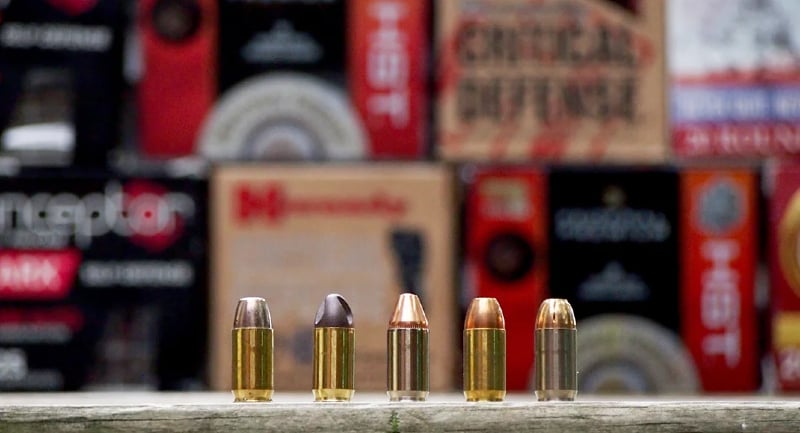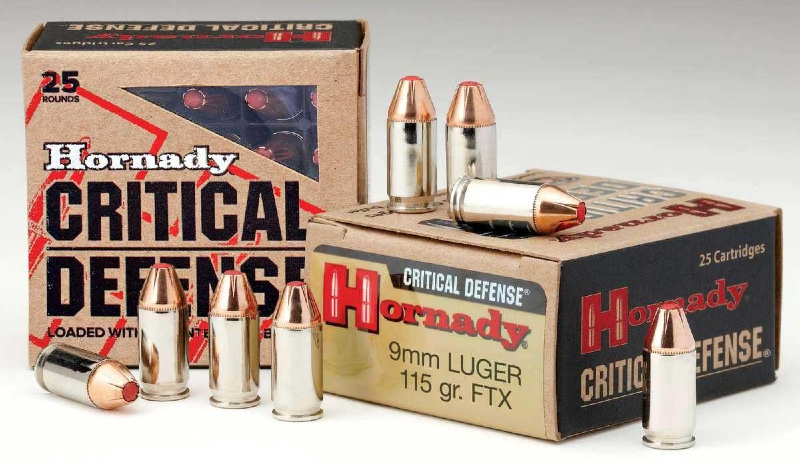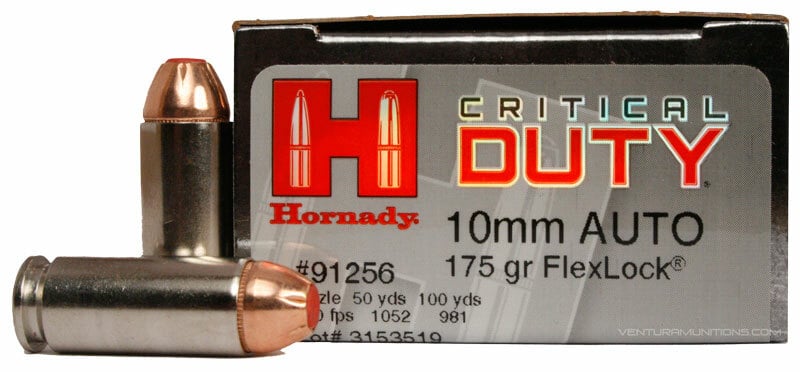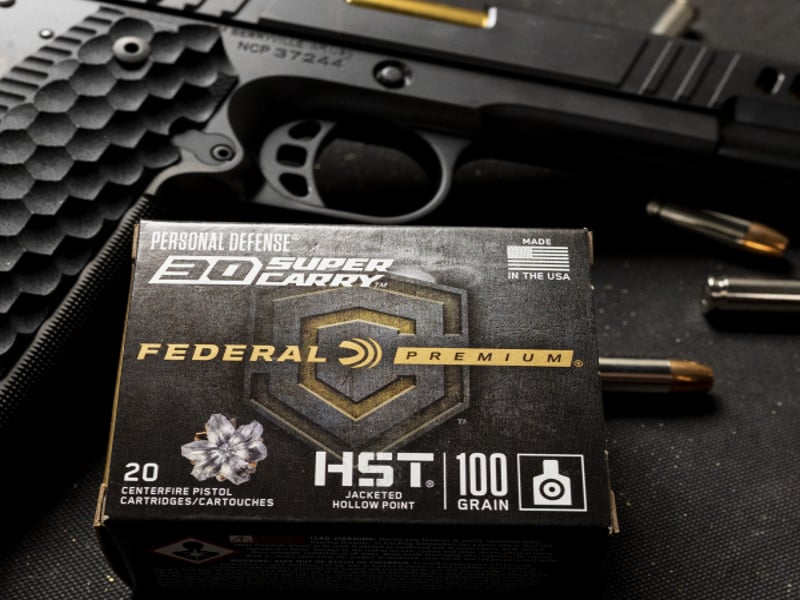It might seem like old news, but one fight that never dies in the gun world is the great caliber debate. This is especially true when it comes to defensive handgunners, maybe because we tend to be so deeply entrenched in our beliefs, even if they’re a little outdated. Now that even more defensive calibers have hit the market, the debate will probably go on forever. Whether you’re trying to choose a new defensive handgun cartridge, trying to justify your personal opinion, or interested in learning more, you’ve come to the right place.
There are a lot of cartridges available out there – we’ll start with a handful here and cover more in future expansions.

The Cool Caliber Kids
A few cartridges have been favorites for some time and continue to hold the lead in the race to be the best. Perhaps the most popular are 380 ACP, 9mm, and 10mm, although it’s worth considering the new 30 Super Carry cartridge. For the sake of not turning this into an encyclopedia of ammunition, we’re going to stick to some of those more commonly used rounds.
380 ACP

The 380 ACP seems to be one of those rounds you either love or hate. Even so, it’s always done well in the defensive handgun market, probably because a lot of gun owners want super-concealable little pistols, and those are frequently chambered in 380 ACP.
A common point of confusion—and argument—among gun owners concerning the 380 ACP versus 9mm debate revolves around the two cartridges matching bullet diameters. However, just because they both have a 0.355-inch bullet diameter doesn’t mean they deliver identical performance. According to SAAMI (Sporting Arms and Ammunition Manufacturer’s Institute), the maximum pressure for 380 ACP is 21,500 psi while the 9mm has a maximum pressure of 35,000 psi. That means the 9mm propels its bullet with significantly greater velocity. Does this mean 380 ACP is the weakest possible option?
This is one of those “yes…and no” answers. Shot placement might sound like a cliché, but it’s accurate to state shot placement matters a great deal. If you can’t hit your target it’s not going to matter what cartridge your gun is chambered in. That said, if you made the same, precise shot with identical placement with a 380 ACP and a 9mm, the 9mm would certainly create a larger wound cavity.
Another myth about 380 ACP is that guns chambered in this cartridge are softer shooters and don’t have as much felt recoil. In reality, many—most—380 ACP guns are snappy and have noticeable felt recoil and muzzle rise. There are some exceptions, such as the Smith & Wesson EZ, but that’s because it was specifically designed to be larger, heavier, and to mitigate recoil and muzzle rise. Smaller pistols are going to be snappier than their heavier cousins which can translate to discomfort while shooting and difficulty reacquiring targets.
Specifications
- Cartridge: 380 ACP
- Designer: John Moses Browning
- Produced: 1908-Present
- Bullet Diameter: 0.355 inches
- Overall Length: 0.984 inches
- Maximum Pressure: 21,500 psi (SAAMI)
9mm

Now we come to what is inarguably the current favorite in the defensive handgun realm: 9mm. Technology has gone far over the years. which is a big part of what helped 9mm along, but it’s also true that the favor shown to it by various branches of law enforcement has made a difference. Many gun owners follow the cues of the FBI, among other alphabet agencies. As a result, it’s become perhaps the most widely-produced ammunition around, and there are basically endless gun models for it available.
All that favoritism doesn’t mean 9mm isn’t a solid self-defense choice. One of the bonuses to its popularity is that there are a lot of different loads and they’ve all been tested extensively. After all, ammunition doesn’t behave identically in every gun. You need to spend time finding out what works for your gear and needs, and ammo testing is part of that process. Thanks to the massive amount of information on 9mm, you can narrow your defensive load choices down rather quickly.
9mm is often seen as a happy medium between the less powerful 380 ACP and the potentially overdone 10mm. Over-penetration is possible with any projectile, but using something like 9mm with a load made for defensive use cuts the risk down. Testing shows 9mm meets FBI standards for penetration and many ammo makers have data to back up their claims regarding weight retention and reliable expansion. If 9mm is your top pick, it’s understandable.
Specifications
- Cartridge: 9x19mm Parabellum/Luger
- Designer: Georg Luger
- Produced: 1902-Present
- Bullet Diameter: 0.355 inches
- Overall Length: 1.169 inches
- Maximum Pressure: 35,000 psi (SAAMI)
10mm

Ah, 10mm. It had to be included because this is a cartridge that seems to be getting more attention lately from the defense side of the industry. Guns chambered in 10mm have been produced with more frequency and some gun owners are at least considering its worthiness for self-defense. Others see it as fully the purview of handgun hunters and hobbyists. Which side is right?
The truth about 10mm falls somewhere in the middle. It does have a broader bullet diameter and higher maximum pressure, and yes, it will create a larger wound cavity. However, over-penetration is a significant risk if you’re using 10mm for self-defense purposes. Can it be used for self-defense? Yes, but you’d better spend time researching and testing ammunition to be sure you choose the best possible load.
A common misconception about 10mm is that it’s hard to control and produces punishing recoil. Yes, there’s more felt recoil running a gun chambered in 10mm than one in 9mm, but it isn’t so much as to be problematic for most shooters. The size of the gun you’re using will make a difference. Heavier guns with longer barrels have less felt recoil and muzzle rise than smaller guns. In addition, the ammunition being used matters. Some are loaded hotter than others, and higher-power rounds are going to hit harder. A good example of a surprisingly easy-to-manage 10mm is the Glock 29. It’s a compact pistol that can still be concealed and it’s large enough to negate much of the 10mm’s recoil. The fact that it’s also quite accurate is an excellent bonus.
As with any ammo, you are responsible for every round you fire, and there’s always a risk of a missed shot or an over-penetrating bullet striking an innocent person. Try out guns chambered in this cartridge before buying one and be sure to pay attention to the weight and barrel length. And remember, although it’s been getting attention lately, there’s a reason it isn’t typically seen as an ideal carry round.
Specifications
- Cartridge: 10mm Auto
- Designer: FFV Norma AB and Col. Jeff Cooper
- Produced: 1983-Present
- Bullet Diameter: 0.4005 inches
- Overall Length: 1.260 inches
- Maximum Pressure: 37,500 psi (SAAMI)
30 Super Carry

The 30 Super Carry is the new kid on the block, something that becomes even more clear when you compare its 2022 launch to the decades and centuries behind other cartridges.
Federal Premium designed it as a competitor for 9mm and probably also for 380 ACP, but ballistically it does make obvious strides beyond the latter. The bullet diameter of the 30 Super Carry is only 0.313 inches according to the paperwork Federal submitted to SAAMI, making it fairly slim compared to the other contenders. Of course, that smaller size means you can fit more of these rounds into a gun than can be managed using larger cartridges. And because it was so carefully created by the team at Federal, you get those extra rounds without noticeably sacrificing terminal performance.
Testing hasn’t been extensive enough outside the factory yet to make a judgment call on 30 Super Carry that isn’t heavily biased by Federal’s own data. However, initial appearances indicate that this is a capable defensive load that could indeed potentially unseat another cartridge. In order for that to happen, it’s going to have to prove itself and capture the attention of firearms manufacturers, because there need to be a lot more guns available chambered in it. It does show promise, though, which is why it’s worth a mention here.
Specifications
- Cartridge: 30 Super Carry
- Designer: Federal Premium
- Produced: 2022-Present
- Bullet Diameter: 0.312 inches (per Federal Premium press release)
- 0.313 inches (submitted to SAAMI)
- Overall Length: 1.169 inches
- Maximum Pressure: 45,000 psi (submitted to SAAMI)
And the Cartridge Contest Winner Is…
From a factual standpoint, the 10mm produces the greatest velocity and largest wound cavities of all these cartridges. There’s no arguing that. Those aren’t the only parameters by which you should be measuring defensive loads, though. Bigger isn’t necessarily better; if bigger was always better we’d all be toting 44 Magnums.
| Defensive Load | Hornady Critical Defense 380 ACP 90 grain FTX | Hornady Critical Defense 9mm 115 grain FTX | Hornady Critical Duty 10mm 175 grain FlexLock | Federal Premium HST 30 Super Carry 100 grain JHP |
| Muzzle energy | 200 foot-pounds | 332 foot-pounds | 523 foot-pounds | 347 foot-pounds |
| Muzzle velocity | 1000 feet per second | 1135 feet per second | 1160 feet per second | 1250 feet per second |
| Sectional density | 0.102 inches | 0.130 inches | 0.156 inches | Unknown |
| Penetration depth (ballistic gel with heavy fabric) | 13.20 inches (average of 5 shots) | 13.31 inches (average of 5 shots) | 19.8 inches (average of 5 shots) | 15.5 inches (manufacturer tested) |
Ballistically, the 9mm has the longest proven history as a defensive round. 380 ACP does have a lot going for it, including proof that it works, but when it comes right down to it, logic dictates that the 9mm has an edge over the smaller cartridge. Where does that leave 30 Super Carry? At this time it’s difficult to say, but it would appear to fall somewhere between 380 ACP and 9mm with the potential of knocking 9mm off its pedestal with the passage of enough time.
A lot of people will tell you having any gun is better than having no gun at all or that the gun you have on hand is the best gun for you. There’s some truth to that. You do need to be capable of hitting what you aim at with your gun and it helps if the gun is reliable and chambered in a good defensive cartridge. Yes, you could easily use an example to prove that point— Bella Twin, for one, who successfully killed a bear using a 22 LR back in 1953. But those situations tend to be the exception to the rule and it’s important to remember that. Conversely, many homicide detectives and emergency room doctors will say they deal with a lot of effective 380 ACP use.
What this comes down to is what you want to trust your life with and what your skill level can handle. This will be a significant part of deciding the best concealed carry gun for you. If you’re only comfortable with something diminutive like a 22 LR, work on your shooting skills so you can level up to a bigger caliber. Above all else, train. It won’t matter what caliber gun you have if you aren’t skilled enough to use it effectively at the moment it matters most.


